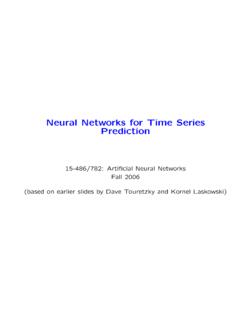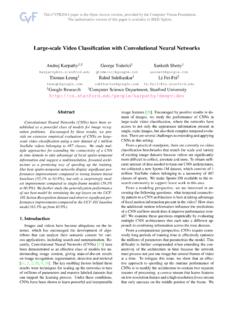Transcription of Identity Mappings in Deep Residual Networks arXiv:1603 ...
1 Identity Mappings in Deep Residual NetworksKaiming He, Xiangyu Zhang, Shaoqing Ren, and Jian SunMicrosoft ResearchAbstractDeep Residual Networks [1] have emerged as a family of ex-tremely deep architectures showing compelling accuracy and nice con-vergence behaviors. In this paper, we analyze the propagation formu-lations behind the Residual building blocks, which suggest that the for-ward and backward signals can be directly propagated from one blockto any other block, when using Identity Mappings as the skip connec-tions and after-addition activation. A series of ablation experiments sup-port the importance of these Identity Mappings .
2 This motivates us topropose a new Residual unit, which makes training easier and improvesgeneralization. We report improved results using a 1001-layer ResNeton CIFAR-10 ( error) and CIFAR-100, and a 200-layer ResNeton ImageNet. Code is available at: IntroductionDeep Residual Networks (ResNets) [1] consist of many stacked Residual Units .Each unit (Fig. 1 (a)) can be expressed in a general form:yl=h(xl) +F(xl,Wl),xl+1=f(yl),wherexlandxl+1are input and output of thel-th unit, andFis a residualfunction. In [1],h(xl) =xlis an Identity mapping andfis a ReLU [2] that are over 100-layer deep have shown state-of-the-art accuracy forseveral challenging recognition tasks on ImageNet [3] and MS COCO [4] compe-titions.
3 The central idea of ResNets is to learn the additive Residual functionFwith respect toh(xl), with a key choice of using an Identity mappingh(xl) = is realized by attaching an Identity skip connection ( shortcut ).In this paper, we analyze deep Residual Networks by focusing on creating a direct path for propagating information not only within a Residual unit,but through the entire network . Our derivations reveal thatif bothh(xl)andf(yl)are Identity Mappings , the signal could bedirectlypropagated from oneunit to any other units, in both forward and backward passes. Our experimentsempirically show that training in general becomes easier when the architectureis closer to the above two understand the role of skip connections, we analyze and compare varioustypes ofh(xl).
4 We find that the Identity mappingh(xl) =xlchosen in [1] [ ] 25 Jul 201620123456x 10405101520 IterationsTest Error (%) LossResNet 1001, original (error: )ResNet 1001, proposed (error: )BNReLUweightBNweightadditionReLUxlxl+1( a) originalReLUweightBNReLUweightBNaddition xlxl+1(b) proposedFigure 1. Left: (a) original Residual Unit in [1]; (b) proposed Residual Unit. The greyarrows indicate the easiest paths for the information to propagate, corresponding tothe additive term xl in Eqn.(4) (forward propagation) and the additive term 1 inEqn.(5) (backward propagation).Right: training curves on CIFAR-10 of1001-layerResNets.
5 Solid lines denote test error (y-axis on the right), and dashed lines denotetraining loss (y-axis on the left). The proposed unit makes ResNet-1001 easier to the fastest error reduction and lowest training loss among all variantswe investigated, whereas skip connections of scaling, gating [5,6,7], and 1 1convolutions all lead to higher training loss and error. These experiments suggestthat keeping a clean information path (indicated by the grey arrows in Fig. 1, 2,and 4) is helpful for easing construct an Identity mappingf(yl) =yl, we view the activation func-tions (ReLU and BN [8]) as pre-activation of the weight layers, in contrastto conventional wisdom of post-activation.
6 This point of view leads to a newresidual unit design, shown in (Fig. 1(b)). Based on this unit, we present com-petitive results on CIFAR-10/100 with a 1001-layer ResNet, which is much easierto train and generalizes better than the original ResNet in [1]. We further reportimproved results on ImageNet using a 200-layer ResNet, for which the counter-part of [1] starts to overfit. These results suggest that there is much room toexploit the dimension ofnetwork depth, a key to the success of modern Analysis of Deep Residual NetworksThe ResNets developed in [1] aremodularizedarchitectures that stack buildingblocks of the same connecting shape.
7 In this paper we call these blocks Residual3 Units . The original Residual Unit in [1] performs the following computation:yl=h(xl) +F(xl,Wl),(1)xl+1=f(yl).(2)Herexlis the input feature to thel-th Residual {Wl,k|1 k K}is aset of weights (and biases) associated with thel-th Residual Unit, andKis thenumber of layers in a Residual Unit (Kis 2 or 3 in [1]).Fdenotes the residualfunction, , a stack of two 3 3 convolutional layers in [1]. The functionfisthe operation after element-wise addition, and in [1]fis ReLU. The functionhis set as an Identity mapping:h(xl) = also an Identity mapping:xl+1 yl, we can put Eqn.(2) into Eqn.(1)and obtain:xl+1=xl+F(xl,Wl).
8 (3)Recursively (xl+2=xl+1+F(xl+1,Wl+1) =xl+F(xl,Wl) +F(xl+1,Wl+1), etc.) wewill have:xL=xl+L 1 i=lF(xi,Wi),(4)forany deeper unitLandany shallower unitl. Eqn.(4) exhibits some niceproperties.(i)The featurexLof any deeper unitLcan be represented as thefeaturexlof any shallower unitlplus a Residual function in a form of L 1i=lF,indicating that the model is in aresidualfashion between any unitsLandl.(ii)The featurexL=x0+ L 1i=0F(xi,Wi), of any deep unitL, is thesummationof the outputs of all preceding Residual functions (plusx0). This is in contrast toa plain network where a featurexLis a series of matrix-vectorproducts, say, L 1i=0 Wix0(ignoring BN and ReLU).
9 Eqn.(4) also leads to nice backward propagation properties. Denoting theloss function asE, from the chain rule of backpropagation [9] we have: E xl= E xL xL xl= E xL(1 + xlL 1 i=lF(xi,Wi)).(5)Eqn.(5) indicates that the gradient E xlcan be decomposed into two additiveterms: a term of E xLthat propagates information directly without concern-ing any weight layers, and another term of E xL( xl L 1i=lF)that propagatesthrough the weight layers. The additive term of E xLensures that information isdirectly propagated back toany shallower unitl. Eqn.(5) also suggests that it1It is noteworthy that there are Residual Units for increasing dimensions and reducingfeature map sizes [1] in whichhis not Identity .
10 In this case the following derivationsdo not hold strictly. But as there are only a very few such units (two on CIFAR andthree on ImageNet, depending on image sizes [1]), we expect that they do not havethe exponential impact as we present in Sec. 3. One may also think of our derivationsas applied to all Residual Units within the same feature map unlikely for the gradient E xlto be canceled out for a mini-batch, because ingeneral the term xl L 1i=lFcannot be always -1 for all samples in a implies that the gradient of a layer does not vanish even when the weightsare arbitrarily (4) and Eqn.(5) suggest that the signal can be directly propagated fromany unit to another, both forward and backward.


![arXiv:0706.3639v1 [cs.AI] 25 Jun 2007](/cache/preview/4/1/3/9/3/1/4/b/thumb-4139314b93ef86b7b4c2d05ebcc88e46.jpg)

![arXiv:1301.3781v3 [cs.CL] 7 Sep 2013](/cache/preview/4/d/5/0/4/3/4/0/thumb-4d504340120163c0bdf3f4678d8d217f.jpg)
![@google.com arXiv:1609.03499v2 [cs.SD] 19 Sep 2016](/cache/preview/c/3/4/9/4/6/9/b/thumb-c349469b499107d21e221f2ac908f8b2.jpg)









